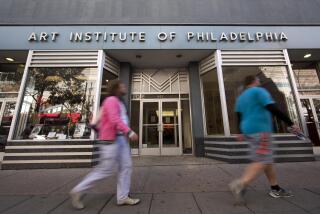Student Loan Firm’s Investors Anxiously Await Results of Audit
- Share via
Government and private agencies are putting the finishing touches on their joint audit of student-loan processing problems at United Education & Software, problems that have clobbered the Encino company’s stock but left its profits unaffected so far.
Those agencies, together with officials from United Education and various lenders, will meet in San Francisco later this week to discuss the problems, after which the results of the audit could be disclosed, said Dewey Newman, deputy assistant secretary for student financial assistance at the U.S. Department of Education.
United Education operates a chain of trade schools, but also has a growing business servicing students loans for a fee.
The problems the company has center on claims that United Education filed in an effort to get reimbursement for student loans that were in default. But two agencies that guarantee student loans on behalf of the federal government have rejected 20,000 of United Education’s claims in the past year because the company’s files contained incomplete or false information.
Newman declined comment on the audit’s results except to say that “to date there hasn’t been any fraud found” on United Education’s part.
Audit Revealed
United Education disclosed the joint review on Aug. 2, and blamed the problems on a change in its computer software. But overall, the company has been reluctant to comment until the review’s results are known.
“Unless we have something meaningful to report, we’re loathe to say much,” said Neil Berkman, an outside spokesman for United Education.
Amid the silence, investors’ fears that the problems could reverse UES’ recent strong earnings growth have knocked its stock down about 70% since April, to a close of $5.125 a share Monday in over-the-counter trading (adjusted for a 3-for-2 split last spring). But in its fiscal second quarter, at least, United Education’s profits continued growing.
The company’s net income in the quarter that ended July 31 jumped 47% to $1.18 million, from $798,000 a year earlier. Revenue rose to $24.3 million from $17.4 million. For the first half of its fiscal year, United Education’s earnings surged 85% to $2.27 million, from $1.23 million, and six-month revenue climbed to $49.7 million from $33.1 million.
Because government-backed student aid is a complicated program, so too is United Education’s situation, involving a host of agencies and companies that constitute an alphabet soup of acronyms.
Collecting Payments
United Education collects payments on about $1 billion worth of student loans owned by California Student Loan Finance Corp. (CSLFC), a nonprofit group that buys the loans from the banks and other financial institutions that originally lent the money.
When students default on those loans, part of United Education’s job is to seek reimbursement for CSLFC. First, however, United Education is supposed to follow certain procedures to notify the student that the loan is due, such as sending letters and making telephone calls. Much of the processing is done by computer.
If the student still doesn’t pay, the company files a claim with an agency that has guaranteed the loan on behalf of the U.S. government, such as the California Student Aid Commission in Sacramento or the Higher Education Assistance Foundation (HEAF) in St. Paul, Minn. If a default claim is complete, those groups reimburse United Education, which in turn forwards the money to CSLFC.
However, early this month United Education’s loan-processing activities came under a joint review by HEAF, the California Student Aid Commission and the U.S. Department of Education because thousands of claims had incomplete or false documentation.
On June 24, HEAF stopped paying all United Education’s claims after realizing that it had already rejected between 5,000 and 6,000 claims filed by the company, said HEAF President Garry Hays. He said the trend was not immediately noticed because HEAF receives thousands of claims from several lenders and loan-servicing companies such as United Education.
Claims Rejected
“For some period of time last year we were rejecting every claim that came in,” Hays said of United Education’s claims. HEAF overall backs about $300 million of the loans serviced by UES.
HEAF had reimbursed United Education for $5.9 million in claims that were complete, but “most of those were new delinquencies, not part of the original” 6,000 in claims that were rejected, he said.
Likewise, the California Student Aid Commission rejected 14,000 claims filed by United Education in the past year mostly because of inadequate documentation, commission spokesman Dan Parker confirmed. He noted that United Education and other loan processors are allowed to resubmit the claims if they correct the problems.
For example, some claim files submitted by United Education included copies of “final demand letters” demanding payment from students, letters that are supposed to be sent before the company can be reimbursed, Hays said. Yet “for some period of time final demand letters were not in fact mailed to students,” he said.
Even without any findings of fraud, the recent audit could cost United Education some money. One scenario would have the Education Department refusing to pay off the defaulted loans in question because of United Education’s mistakes, leaving the liability to HEAF or another guarantor. The guarantors, in turn, might sue United Education or CSLFC for payments.
Another scenario would have the auditors working with United Education to solve the problems. But even that course likely would lift United Education’s operating costs, which would erode its earnings.
The growth of UES’ loan-processing service has been explosive--from $22 million in January 1984 to $1 billion today--and sources close to the company said there were signs UES has struggled to keep up.
For instance, auditors recently inspecting UES’ data-services center in Costa Mesa found cartons of unopened letters to students that had been returned to UES because they had incorrect addresses, said the sources, who agreed to speak on the condition that they not be identified.
David Butterworth, who follows UES for Wedbush Securities, said investors are worried that UES could not only face some financial liability for the mistakes, but that CSLFC might take its business elsewhere.
If so, “that’s 30% of United Education’s earnings walking out the door,” Butterworth said.
More to Read
Sign up for Essential California
The most important California stories and recommendations in your inbox every morning.
You may occasionally receive promotional content from the Los Angeles Times.











